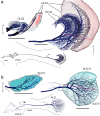Anatomy of the lobula complex in the brain of the praying mantis compared to the lobula complexes of the locust and cockroach
- PMID: 28295329
- PMCID: PMC5435961
- DOI: 10.1002/cne.24208
Anatomy of the lobula complex in the brain of the praying mantis compared to the lobula complexes of the locust and cockroach
Abstract
The praying mantis is an insect which relies on vision for capturing prey, avoiding being eaten and for spatial orientation. It is well known for its ability to use stereopsis for estimating the distance of objects. The neuronal substrate mediating visually driven behaviors, however, is not very well investigated. To provide a basis for future functional studies, we analyzed the anatomical organization of visual neuropils in the brain of the praying mantis Hierodula membranacea and provide supporting evidence from a second species, Rhombodera basalis, with particular focus on the lobula complex (LOX). Neuropils were three-dimensionally reconstructed from synapsin-immunostained whole mount brains. The neuropil organization and the pattern of γ-aminobutyric acid immunostaining of the medulla and LOX were compared between the praying mantis and two related polyneopteran species, the Madeira cockroach and the desert locust. The investigated visual neuropils of the praying mantis are highly structured. Unlike in most insects the LOX of the praying mantis consists of five nested neuropils with at least one neuropil not present in the cockroach or locust. Overall, the mantis LOX is more similar to the LOX of the locust than the more closely related cockroach suggesting that the sensory ecology plays a stronger role than the phylogenetic distance of the three species in structuring this center of visual information processing.
Keywords: RRID: AB_2313575; RRID: AB_2314457; RRID: AB_2315056; RRID: AB_2315425; RRID: AB_2336990; RRID: AB_2337244; RRID: AB_2338006; RRID: AB_2338713; RRID: AB_261363; RRID: nif-0000-00262; cockroach; insect visual system; lobula complex; locust; praying mantis.
© 2017 The Authors The Journal of Comparative Neurology Published by Wiley Periodicals, Inc.
Figures









Similar articles
-
Anatomical organization of the cerebrum of the praying mantis Hierodula membranacea.J Comp Neurol. 2024 Mar;532(3):e25607. doi: 10.1002/cne.25607. J Comp Neurol. 2024. PMID: 38501930
-
Unraveling the functional organization of lobula complex in the mantis brain by identification of visual interneurons.J Comp Neurol. 2019 May 1;527(7):1161-1178. doi: 10.1002/cne.24603. Epub 2019 Jan 4. J Comp Neurol. 2019. PMID: 30552687
-
Organization and neural connections of the lateral complex in the brain of the desert locust.J Comp Neurol. 2021 Oct;529(15):3533-3560. doi: 10.1002/cne.25209. Epub 2021 Jul 16. J Comp Neurol. 2021. PMID: 34216020
-
Evolution of the central complex in the arthropod brain with respect to the visual system.Arthropod Struct Dev. 2008 Sep;37(5):347-62. doi: 10.1016/j.asd.2008.01.008. Epub 2008 Feb 19. Arthropod Struct Dev. 2008. PMID: 18502176 Review.
-
Functional morphology of the praying mantis male genitalia (Insecta: Mantodea).Arthropod Struct Dev. 2023 May;74:101267. doi: 10.1016/j.asd.2023.101267. Epub 2023 Apr 27. Arthropod Struct Dev. 2023. PMID: 37119794 Review.
Cited by
-
Inverse resource allocation between vision and olfaction across the genus Drosophila.Nat Commun. 2019 Mar 11;10(1):1162. doi: 10.1038/s41467-019-09087-z. Nat Commun. 2019. PMID: 30858374 Free PMC article.
-
Predatory behavior under monocular and binocular conditions in the semiterrestrial crab Neohelice granulata.Front Behav Neurosci. 2023 May 25;17:1186518. doi: 10.3389/fnbeh.2023.1186518. eCollection 2023. Front Behav Neurosci. 2023. PMID: 37304759 Free PMC article.
-
Matched function of the neuropil processing optic flow in flies and crabs: the lobula plate mediates optomotor responses in Neohelice granulata.Proc Biol Sci. 2022 Aug 31;289(1981):20220812. doi: 10.1098/rspb.2022.0812. Epub 2022 Aug 17. Proc Biol Sci. 2022. PMID: 35975436 Free PMC article.
-
Gross anatomy of the visual processing centers of Hieroglyphus banian.Cell Tissue Res. 2025 Apr;400(1):35-49. doi: 10.1007/s00441-025-03956-4. Epub 2025 Feb 12. Cell Tissue Res. 2025. PMID: 39934293
-
Neurons sensitive to non-celestial polarized light in the brain of the desert locust.J Comp Physiol A Neuroethol Sens Neural Behav Physiol. 2023 Nov;209(6):907-928. doi: 10.1007/s00359-023-01618-w. Epub 2023 Feb 21. J Comp Physiol A Neuroethol Sens Neural Behav Physiol. 2023. PMID: 36809566 Free PMC article.
References
-
- Beetz, M. J. , el Jundi, B. , Heinze, S. , & Homberg, U. (2015). Topographic organization and possible function of the posterior optic tubercles in the brain of the desert locust Schistocerca gregaria . The Journal of Comparative Neurology, 523, 1589–1607. - PubMed
-
- Berger, F. A. (1985). Morphologie und Physiologie einiger visueller Interneuronen in den optischen Ganglien der Gottesanbeterin Mantis religiosa. (Doctoral dissertation). University of Düsseldorf, Düsseldorf, Germany.
-
- Borst, A. , Haag, J. , & Reiff, D. F. (2010). Fly motion vision. Annual Review of Neuroscience, 33, 49–70. - PubMed
-
- Borst, A. , & Helmstaedter, M. (2014). Common circuit design in fly and mammalian motion vision. Nature Neuroscience, 18, 1067–1076. - PubMed
Publication types
MeSH terms
LinkOut - more resources
Full Text Sources
Other Literature Sources

